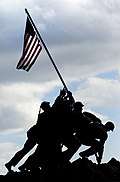Military history of African Americans
The military history of African Americans spans from the arrival of the first enslaved Africans during the colonial history of the United States to the present day. In every war fought by or within the United States, African Americans participated, including the Revolutionary War, the War of 1812, the Mexican–American War, the Civil War, the Spanish–American War, the World Wars, the Korean War, the Vietnam War, the Gulf War, and the wars in Afghanistan and Iraq as well as other minor conflicts.
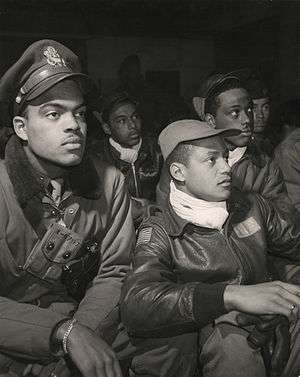
Revolutionary War
| Part of a series on | ||||||||||||
| African Americans | ||||||||||||
|---|---|---|---|---|---|---|---|---|---|---|---|---|
|
||||||||||||
|
||||||||||||
|
Religion
|
||||||||||||
|
Politics
|
||||||||||||
|
Civic / economic groups
|
||||||||||||
|
Sports
|
||||||||||||
|
Sub-communities
|
||||||||||||
|
Dialects and languages
|
||||||||||||
|
Population
|
||||||||||||
| ||||||||||||

African Americans as slaves and free blacks served on both sides during the war. Gary Nash reports that recent research concludes there were about 9,000 black Patriot soldiers, counting the Continental Army and Navy, and state militia units, as well as privateers, wagoneers in the Army, servants to officers, and spies.[1] Ray Raphael notes that while thousands did join the Loyalist cause, "A far larger number, free as well as slave, tried to further their interests by siding with the patriots."[2]
Black soldiers served in Northern militias from the outset, but this was forbidden in the South, where slave-owners feared arming slaves. Lord Dunmore, the Royal Governor of Virginia, issued an emancipation proclamation in November 1775, promising freedom to runaway slaves who fought for the British; Sir Henry Clinton issued a similar edict in New York in 1779.[3] Over 100,000 slaves escaped to the British lines, although possibly as few as 1,000 served under arms. Many of the rest served as orderlies, mechanics, laborers, servants, scouts and guides, although more than half died in smallpox epidemics that swept the British forces, and many were driven out of the British lines when food ran low. Despite Dunmore's promises, the majority were not given their freedom. Many Black Loyalists' descendants now live in Canada and Sierra Leone. Many of the Black Loyalists performed military service in the British Army, particularly as part of the only Black regiment of the war, the Black Pioneers, and others served non-military roles.
In response, and because of manpower shortages, Washington lifted the ban on black enlistment in the Continental Army in January 1776. All-black units were formed in Rhode Island and Massachusetts; many were slaves promised freedom for serving in lieu of their masters; another all-African-American unit came from Haiti with French forces. At least 5,000 African-American soldiers fought as Revolutionaries, and at least 20,000 served with the British.
Peter Salem and Salem Poor are the most noted of the African-American Patriots during this era, and Colonel Tye was perhaps the most noteworthy Black Loyalist.
Black volunteers also served with various of the South Carolina guerrilla units, including that of the "Swamp Fox", Francis Marion,[4] half of whose force sometimes consisted of free Blacks. These Black troops made a critical difference in the fighting in the swamps, and kept Marion's guerrillas effective even when many of his White troops were down with malaria or yellow fever.
The first black American to fight in the Marines was John Martin, also known as Keto, the slave of a Delaware man, recruited in April 1776 without his owner's permission by Captain of the Marines Miles Pennington of the Continental brig USS Reprisal. Martin served with the Marine platoon on the Reprisal for a year and a half and took part in many ship-to-ship battles including boardings with hand-to-hand combat, but he was lost with the rest of his unit when the brig sank in October 1777.[5] At least 12 other black men served with various American Marine units in 1776–1777; more may have been in service but not identified as blacks in the records. However, in 1798 when the United States Marine Corps (USMC) was officially re-instituted, Secretary of War James McHenry specified in its rules: "No Negro, Mulatto or Indian to be enlisted".[5] Marine Commandant William Ward Burrows instructed his recruiters regarding USMC racial policy, "You can make use of Blacks and Mulattoes while you recruit, but you cannot enlist them."[5] This policy was in line with long-standing British naval practice which set a higher standard of unit cohesion for Marines, the unit to be made up of only one race, so that the members would remain loyal, maintain shipboard discipline and help put down mutinies.[5] The USMC maintained this policy until 1942.[6][7]
War of 1812
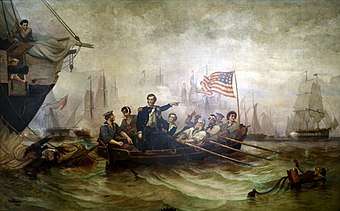
During the War of 1812, about one-quarter of the personnel in the American naval squadrons of the Battle of Lake Erie were black, and portrait renderings of the battle on the wall of the nation's Capitol and the rotunda of Ohio's Capitol show that blacks played a significant role in it. Hannibal Collins, a freed slave and Oliver Hazard Perry's personal servant, is thought to be the oarsman in William Henry Powell's Battle of Lake Erie.[9] Collins earned his freedom as a veteran of the Revolutionary War, having fought in the Battle of Rhode Island. He accompanied Perry for the rest of Perry's naval career, and was with him at Perry's death in Trinidad in 1819.[10]
No legal restrictions regarding the enlistment of blacks were placed on the Navy because of its chronic shortage of manpower. The law of 1792, which generally prohibited enlistment of blacks in the Army became the United States Army's official policy until 1862. The only exception to this Army policy was Louisiana, which gained an exemption at the time of its purchase through a treaty provision, which allowed it to opt out of the operation of any law, which ran counter to its traditions and customs. Louisiana permitted the existence of separate black militia units which drew its enlistees from freed blacks.
A militia unit, In Louisiana, the 2nd Battalion of Free Men of Color, was a unit of black soldiers from Santo Domingo led by a Black free man and Santo-Domingue emigre Joseph Savary offered their services and were accepted by General Andrew Jackson in the Battle of New Orleans, a victory that was achieved after the war was officially over.[11]
Blacks fought at the Battle of Bladensburg 24 August 1814, many as members of Commodore Joshua Barney's naval flotilla force. This force provided crucial artillery support during the battle. One of the best accounts is that Charles Ball born 1785. Ball served with Commodore Joshua at the Battle of Bladensburg and later helped man the defenses at Baltimore. In his 1837 memoir, Ball reflected on the Battle of Bladensburg: "I stood at my gun, until the Commodore was shot down… if the militia regiments, that lay upon our right and left, cold have been brought to charge the British, in close fight, as they crossed the bridge, we should have killed or taken the whole of them in a short time; but the militia ran like sheep chased by dogs."[12] Barney's flotilla group included numerous African Americans who provided artillery support during the battle. Modern scholars estimate blacks made up between 15–20%, of the American naval forces in the War of 1812.[13]
Just before the battle Commodore Barney on being asked by President James Madison "if his negroes would not run on the approach of the British?" replied: "No Sir…they don't know how to run; they will die by their guns first."[14] The Commodore was correct, the men did not run, one such man was young sailor Harry Jones (no.35), apparently a free black. Harry Jones was wounded in the final action at Bladensburg. Due to the severity of Jones wounds, he remained a patient at the Naval Hospital Washington DC for nearly two months.[15]

African Americans also served with the British. On April 2, 1814, Vice Admiral Alexander Cochrane issued a proclamation to all persons wishing to emigrate, similar to the aforementioned Dunmore's Proclamantion some 40 years previous. Any persons would be received by the British, either at a military outpost or aboard British ships; those seeking sanctuary could enter His Majesty's forces, or go "as free settlers to the British possessions in North America or the West Indies".[16][17][18] Among those who went to the British, some joined the Corps of Colonial Marines, an auxiliary unit of marine infantry, embodied on May 14, 1814. British commanders later stated the new marines fought well at Bladensburg and confirm that two companies took part in the burning of Washington including the White House. Following the Treaty of Ghent, the British kept their promise and in 1815 evacuated the Colonial Marines and their families to Halifax Canada and Bermuda.[19]
1815 to 1840
From the Treaty of Ghent to the Mexican-American War, African Americans made up a significant part of the peacetime navy. Data for 1839 was collected by Commodore Lewis Warrington and forwarded to the Secretary of the Navy as a memorandum with the number of recruits from 1 September 1838 to September 17, 1839. This document provides data for five naval recruiting stations which in total reflect 1016 men entered or naval service, "of which 122 were Black" or 12% of the total.[20]
Mexican–American War
A number of African Americans in the Army during the Mexican–American War were servants of the officers who received government compensation for the services of their servants or slaves. Also, soldiers from the Louisiana Battalion of Free Men of Color participated in this war. African Americans also served on a number of naval vessels during the Mexican–American War, including the USS Treasure, and the USS Columbus.[11]
American Civil War
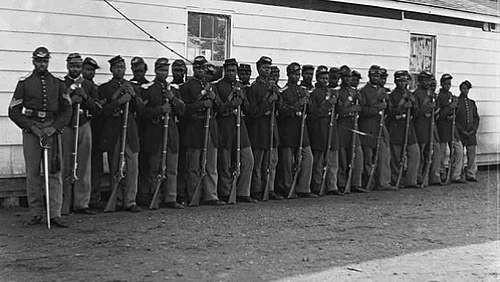
The history of African Americans in the U.S. Civil War is marked by 186,097 (7,122 officers, 178,975 enlisted)[21] African-American men, comprising 163 units, who served in the Union Army during the Civil War, and many more African Americans served in the Union Navy. Both free African Americans and runaway slaves joined the fight.
On the Confederate side, blacks, both free and slave, were used for labor. In the final months of the war, the Confederate Army was desperate for additional soldiers so the Confederate Congress voted to recruit black troops for combat; they were to be promised their freedom. Units were in training when the war ended, and none served in combat.[22]
Indian Wars

From 1863 to the early 20th century, African-American units were utilized by the Army to combat the Native Americans during the Indian Wars.[23] The most noted among this group were the Buffalo Soldiers:
At the end of the U.S. Civil War the army reorganized and authorized the formation of two regiments of black cavalry (the 9th and 10th US Cavalry). Four regiments of infantry (the 38th, 39th, 40th and 41st US Infantry) were formed at the same time. In 1869, the four infantry regiments were merged into two new ones (the 24th and 25th US Infantry). These units were composed of black enlisted men commanded by white officers such as Benjamin Grierson, and occasionally, an African-American officer such as Henry O. Flipper. The "Buffalo Soldiers" served a variety of roles along the frontier from building roads to guarding the U.S. mail.[24]
These regiments served at a variety of posts in the southwest United States and Great Plains regions. During this period they participated in most of the military campaigns in these areas and earned a distinguished record. Thirteen enlisted men and six officers from these four regiments earned the Medal of Honor during the Indian Wars.[25]
Spanish–American War
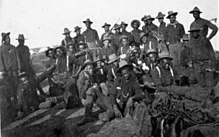
_(14783599362).jpg)
After the Indian Wars ended in the 1890s, the regiments continued to serve and participated in the Spanish–American War (including the Battle of San Juan Hill), where five more Medals of Honor were earned.[26] They took part in the 1916 Punitive Expedition into Mexico and in the Philippine–American War.
Units
In addition to the African Americans who served in regular army units during the Spanish–American War, five African-American Volunteer Army units and seven African-American National Guard units served.
Volunteer Army:
- 7th United States Volunteer Infantry (Colored Troops)
- 8th United States Volunteer Infantry (Colored Troops)
- 9th United States Volunteer Infantry (Colored Troops)
- 10th United States Volunteer Infantry (Colored Troops)
- 11th United States Volunteer Infantry (Colored Troops)
National Guard:
- 3rd Alabama Volunteer Infantry (Colored Troops)
- 8th Illinois Volunteer Infantry (Colored Troops)[27]
- Companies A and B, 1st Indiana Volunteer Infantry (Colored Troops)
- 23rd Kansas Volunteer Infantry (Colored Troops)
- 3rd North Carolina Volunteer Infantry (Colored Troops)
- 9th Ohio Volunteer Infantry (Colored Troops)
- 6th Virginia Volunteer Infantry (Colored Troops)
Of these units, only the 9th U.S., 8th Illinois, and 23rd Kansas served outside the United States during the war. All three units served in Cuba and suffered no losses to combat.
Philippine-American War
After the Treaty of Paris, the islands of the Philippines became a colony of the United States. When the U.S. military started to send soldiers into the islands, native rebels, who had already been fighting their former Spanish rulers, opposed U.S. colonization and retaliated, causing an insurrection. In what would be known as the Philippine-American War, the U.S. military also sent colored regiments and units to stop the insurrection. However, due to the discrimination of African-American soldiers, some of them defected to the Philippine Army.
One of those that defected was David Fagen, who was given the rank of captain in the Philippine Army. Fagen served in the 24th Regiment of the U.S. Army, but on November 17, 1899,[28] he defected to the Filipino army.[29] He became a successful guerrilla leader and his capture became an obsession to the U.S. military and American public. His defection was likely the result of differential treatment by American occupational forces toward black soldiers, as well as common American forces derogatory treatment and views of the Filipino occupational resistance, who were frequently referred to as "niggers" and "gugus".[30]
After two other black deserters were captured and executed, President Theodore Roosevelt announced he would stop executing captured deserters.[31] As the war ended, the US gave amnesties to most of their opponents. A substantial reward was offered for Fagen, who was considered a traitor. There are two conflicting versions of his fate: one is that his was the partially decomposed head for which the reward was claimed, the other is that he took a local wife and lived peacefully in the mountains.[32]
World War I
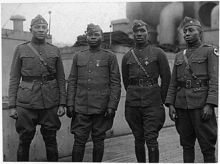
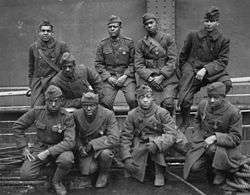
The U.S. armed forces remained segregated through World War I. Still, many African Americans volunteered to join the Allied cause following America's entry into the war. By the time of the armistice with Germany on November 11, 1918, over 350,000 African Americans had served with the American Expeditionary Force on the Western Front.[33]
Most African-American units were largely relegated to support roles and did not see combat. Still, African Americans played a notable role in America's war effort. For example, the 369th Infantry Regiment, known as the "Harlem Hellfighters", was assigned to the French Army and served on the front lines for six months. 171 members of the 369th were awarded the Legion of Merit.

Germany attempted to sway the African American troops with propaganda challenging their race-related rights back in the United States.[34]
Corporal Freddie Stowers of the 371st Infantry Regiment that was seconded to the 157th French Army division called the Red Hand Division in need of reinforcement under the command of the General Mariano Goybet was posthumously awarded a Medal of Honor[35]—the only African American to be so honored for actions in World War I. During action in France, Stowers had led an assault on German trenches, continuing to lead and encourage his men even after being twice wounded. Stowers died from his wounds, but his men continued the fight and eventually defeated the German troops. Stowers was recommended for the Medal of Honor shortly after his death, but the nomination was, according to the Army, misplaced. In 1990, under pressure from Congress, the Department of the Army launched an investigation. Based on findings from this investigation, the Army Decorations Board approved the award of the Medal of Honor to Stowers. On April 24, 1991–73 years after he was killed in action—Stowers' two surviving sisters received the Medal of Honor from President George H. W. Bush at the White House. The success of the investigation leading to Stowers' Medal of Honor later sparked a similar review that resulted in six African Americans being posthumously awarded the Medal of Honor for actions in World War II. Vernon Baker was the only recipient who was still alive to receive his award.[36]
Units
Some of the African-American units that served in World War I were:
_Troops_on_the_Deck_of_the_%22Louisville.%22_Part_of_the_Squadr_._._._-_NARA_-_533486.tif.jpg)
- 92nd Infantry Division[37]
- 93rd Infantry Division
- 369th Infantry Regiment ("Harlem Hellfighters"; formerly the 15th New York National Guard)
- 370th Infantry Regiment ("Black Devils", formerly the 8th Illinois)[38][39]
- 371st Infantry Regiment
- 372nd Infantry Regiment
Support units included:
- Butchery Companies, Nos. 322 and 363
- Stevedore Regiments, Nos. 301, 302 and 303d Stevedore Regiment and Stevedore Battalions, Nos. 701, 702
- Army Corps of Engineers: Engineers Service Battalions, Nos. 505 to 567, inclusive (but skipping 531–532, 538, 537–563) (57 total; about 1008 personnel per battalion)
- Labor Battalions, Nos. 304 to 315, inclusive; Nos. 317 to 327, inclusive; Nos. 329 to 348, inclusive, and No. 357
- Labor Companies, Nos. 301 to 324, inclusive
- Pioneer Infantry Battalions, Nos. 801 to 809, inclusive; No. 811 and Nos. 813 to 816, inclusive.[40]
A complete list of African-American units that served in the war is published in the book Willing Patriots: Men of Color in World War One. The book is cited in the "Further reading" section of this article.
African Americans Veterans faced heavy persecution when they returned home from World War I and many African American veterans were lynched after returning from WWI.
Period between the world wars
Even though the U.S. government was nominally neutral in the wars waged by Fascists against Ethiopia and Fascists and Nazis against the Spanish Republic in the mid-1930s, African Americans found it hard to be neutral and many became Antifascist.[41]
Second Italo-Abyssinian War
On October 4, 1935, Fascist Italy invaded Ethiopia. Being the only non-colonized African country besides Liberia, the invasion of Ethiopia caused a profound response amongst African Americans.[42] African Americans organized to raise money for medical supplies, and many volunteered to fight for the African kingdom.[43] Within eight months, however, Ethiopia was overpowered by the advanced weaponry and mustard gas of the Italian forces.
Many years later Haile Selassie I would comment on the efforts: "We can never forget the help Ethiopia received from Negro Americans during the crisis. ... It moved me to know that Americans of African descent did not abandon their embattled brothers, but stood by us."[43]
Spanish Civil War
When General Franco rebelled against the newly established secular Spanish Republic, a number of African Americans volunteered to fight for Republican Spain. Many African Americans who were in the Abraham Lincoln Brigade had Communist ideals. Among these, there was Vaughn Love who went to fight for the Spanish loyalist cause because he considered Fascism to be the "enemy of all black aspirations."
African-American activist and World War I veteran Oliver Law, fighting in the Abraham Lincoln Brigade during the Spanish Civil War[44]
James Peck was an African-American man from Pennsylvania who was turned down when he applied to become a military pilot in the US. He then went on to serve in the Spanish Republican Air Force until 1938.[45] Peck was credited with shooting down five Aviación Nacional planes, two Heinkel He-51s from the Legion Condor and three Fiat CR.32 Fascist Italian fighters.
Salaria Kea was a young African-American nurse from Harlem Hospital who served as a military nurse with the American Medical Bureau in the Spanish Civil War. She was one of the two only African-American female volunteers in the midst of the war-torn Spanish Republican areas.[46] When Salaria came back from Spain she wrote the pamphlet "A Negro Nurse in Spain" and tried to raise funds for the beleaguered Spanish Republic.[47]
World War II
The Pittsburgh Courier[48]
Despite a high enlistment rate in the U.S. Army, African Americans were not treated equally. At parades, church services, in transportation and canteens the races were kept separate. A quota of only 48 nurses was set for African-American women, and the women were segregated from white nurses and white soldiers for much of the war. Eventually more black nurses enlisted. They were assigned to care for black soldiers. Black nurses were integrated into everyday life with their white colleagues.
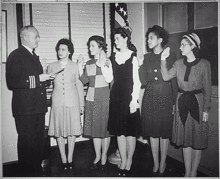
The first African-American woman sworn into the Navy Nurse Corps was Phyllis Mae Dailey, a Columbia University student from New York. She was the first of only four African-American women to serve as a Navy nurse during World War II.[49]
Many soldiers of color served their country with distinction during World War II. There were 125,000 African Americans who were overseas in World War II. Famous segregated units, such as the Tuskegee Airmen and 761st Tank Battalion and the lesser-known but equally distinguished 452nd Anti-Aircraft Artillery Battalion,[50] proved their value in combat, leading to desegregation of all U.S. armed forces by order of President Harry S. Truman in July 1948 via Executive Order 9981.
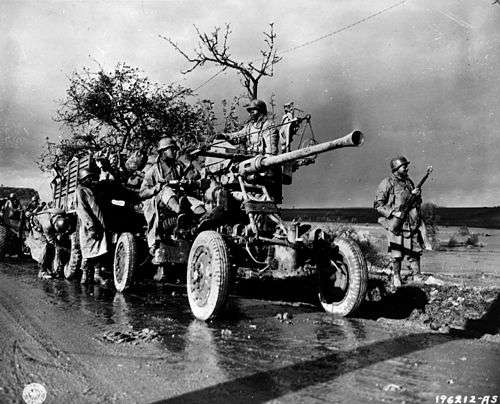
Benjamin O. Davis, Jr. served as commander of the Tuskegee Airmen during the war. He later went on to become the first African-American general in the United States Air Force. His father, Benjamin O. Davis, Sr., had been the first African-American brigadier general in the Army (1940).
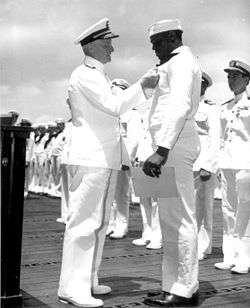
Doris Miller, a Navy mess attendant, was the first African-American recipient of the Navy Cross, awarded for his actions during the attack on Pearl Harbor. Miller had voluntarily manned an anti-aircraft gun and fired at the Japanese aircraft, despite having no prior training in the weapon's use.
In 1944, the Golden Thirteen became the Navy's first African-American commissioned officers. Samuel L. Gravely, Jr. became a commissioned officer the same year; he would later be the first African American to command a US warship, and the first to be an admiral.
The Port Chicago disaster on July 17, 1944, was an explosion of about 2,000 tons of ammunition as it was being loaded onto ships by black Navy sailors under pressure from their white officers to hurry. The explosion in Northern California killed 320 military and civilian workers, most of them black. It led a month later to the Port Chicago Mutiny, the only case of a full military trial for mutiny in the history of the U.S. Navy against 50 African-American sailors who refused to continue loading ammunition under the same dangerous conditions. The trial was observed by the then young lawyer Thurgood Marshall and ended in conviction of all of the defendants. The trial was immediately and later criticized for not abiding by the applicable laws on mutiny, and it became influential in the discussion of desegregation.[51]
During World War II, African-American soldiers served in all fields of service. In the midst of the Battle of the Bulge in December 1944, General Eisenhower was severely short of replacement troops for existing all-white companies. Consequently, he made the decision to allow 2000 black servicemen volunteers to serve in segregated platoons under the command of white lieutenants to replenish these companies.[52] These platoons would serve with distinction and, according to an Army survey in the summer of 1945, 84% were ranked "very well" and 16% were ranked "fairly well". No black platoon received a ranking of "poor" by those white officers or white soldiers that fought with them. These platoons were often subject to racist treatment by white military units in occupied Germany and were quickly sent back to their old segregated units after the end of hostilities in Germany. Despite their protests, these brave African-American soldiers ended the war in their old non-combat service units. Though largely forgotten after the war, the temporary experiment with black combat troops proved a success - a small, but important step toward permanent integration during the Korean War.[53][54] A total of 708 African Americans were killed in combat during World War II.[55]
In 1945, Frederick C. Branch became the first African-American United States Marine Corps officer.
A blue plaque commemorating the contribution of African-American soldiers based in Wales during World War II was installed by the Nubian Jak Community Trust at RAF Carew Cheriton on the 75th anniversary of the D-Day landings, June 6, 2019.[56][57][58]
Units
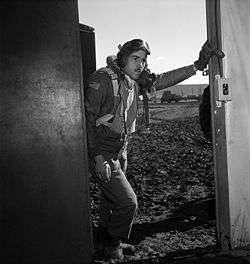
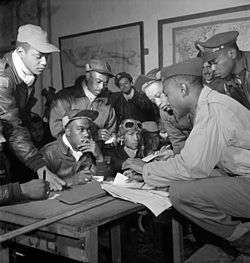

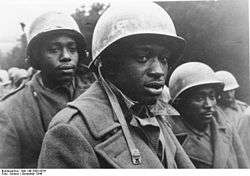
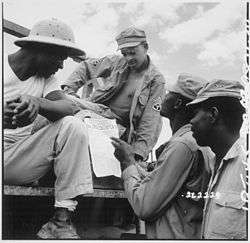
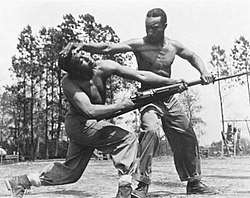
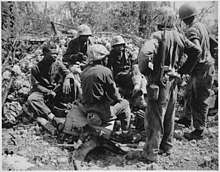
- 92nd Infantry Division
- 93rd Infantry Division
- 2nd Cavalry Division
- Non Divisional Units
- Barrage Balloon Unit
- Anti-Aircraft Artillery Unit
- Infantry Units
- Cavalry/Armor Units
- US Military Academy Cavalry Squadron
- 5th Reconnaissance Squadron
- 758th Tank Battalion
- 761st Tank Battalion
- 784th Tank Battalion
- Field Artillery Units
- 46th Field Artillery Brigade.[63]
- 184th Field Artillery Regiment, Illinois National Guard.
- 333rd Field Artillery Regiment.[64]
- 349th Field Artillery Regiment[65]
- 350th Field Artillery Regiment[66]
- 351st Field Artillery Regiment[67]
- 353rd Field Artillery Regiment[68]
- 578th Field Artillery Regiment[69]
- 333rd Field Artillery Battalion
- 349th Field Artillery Battalion
- 350th Field Artillery Battalion
- 351st Field Artillery Battalion
- 353rd Field Artillery Battalion
- 578th Field Artillery Battalion
- 593rd Field Artillery Battalion
- 594th Field Artillery Battalion
- 595th Field Artillery Battalion
- 596th Field Artillery Battalion
- 597th Field Artillery Battalion
- 598th Field Artillery Battalion
- 599th Field Artillery Battalion
- 600th Field Artillery Battalion
- 686th Field Artillery Battalion
- 777th Field Artillery Battalion
- 795th Field Artillery Battalion
- 930th Field Artillery Battalion, Illinois National Guard
- 931st Field Artillery Battalion, Illinois National Guard
- 969th Field Artillery Battalion
- 971st Field Artillery Battalion
- 973rd Field Artillery Battalion
- 993rd Field Artillery Battalion
- 999th Field Artillery Battalion
- Tank Destroyer Units
- 614th Tank Destroyer Battalion
- 646th Tank Destroyer Battalion
- 649th Tank Destroyer Battalion
- 659th Tank Destroyer Battalion
- 669th Tank Destroyer Battalion
- 679th Tank Destroyer Battalion
- 795th Tank Destroyer Battalion
- 827th Tank Destroyer Battalion
- 828th Tank Destroyer Battalion
- 829th Tank Destroyer Battalion
- 846th Tank Destroyer Battalion
- 332nd Fighter Group (Tuskegee Airmen)
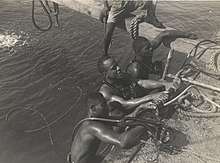
- USS Mason (DE-529)
- USS PC-1264
- 34th Naval Construction Battalion
- 80th Naval Construction Battalion
- 15 USN Special Construction Battalions (stevedore) were segregated.
- 17th Special Naval Construction Battalion
- Naval Ordinance Battalions (stevedore)
- 51st Defense Battalion
- 52nd Defense Battalion
- 63 USMC Depot and Ammunition Companies were segregated.
- 16th Marine Field Depot
In February 1942 CNO Admiral Harold Rainsford Stark recommended African Americans for ratings in the construction trades. In April the Navy announced it would enlist African Americans in the Seabees. Even so, there were just two CBs that were "colored" units, the 34th and 80th.[70] Both had white Southern officers and black enlisted. Both battalions experienced problems with that arrangement that led to the replacement of the officers. The men of the 34th went on a hunger strike which made national news. The Commander of the 80th had 19 enlisted dishonorably discharged for sedition. The NAACP and Thurgood Marshall got 14 of those reversed. In 1943 the Navy drew up a proposal to raise the number of colored CBs to 5 and require that all non-rated men in the next 24 CBs be colored. The proposal was approved, but not acted on.
The lack of stevedores in combat zones was a huge issue for the Navy. Authorization for the formation of cargo handling CBs or "Special CBs" happened mid-September 1942.[71] By wars end 41 Special CBs had been commissioned of which 15 were "colored". They were the first fully integrated units in the U.S. Navy.[70] V-J Day brought the decommissioning of all of them. The Special CBs were forerunners of today's Navy Cargo Handling Battalions of the Navy Expeditionary Logistics Support Group (United States). The arrival of 15 colored Special CBs in Pearl Harbor made segregation an issue for the Navy.[72] For some time the men slept in tents, but the disparity of treatment was obvious even to the Navy.[72] The 14th Naval District felt they deserved proper shelter with at least separate but equal barracks.[72] Manana Barracks and Waiawa Gulch became the United State's largest colored military installation with over 4,000 Seabee stevedores housed there.[72] It was the site of racial strife to the point that the camp was fenced in and placed under armed guard.[72] The Seabees would be trucked back and forth to the docks in cattle trucks.[72] Two naval supply depots were located at Waiawa Gulch.
Of note were the actions of the 17th Special Naval Construction Battalion and the 16th Marine Field Depot on Peleliu, September 15–18, 1944. On D-Day the 7th Marines were in a situation where there were not enough of them to man the lines and get the wounded to safety. Coming to their aid were the two companies of the 16 Marine Field Depot(segregated) and the 17th Special Seabee (segregated). That night the Japanese mounted a counter-attack at 0200 hours. The Field Depot Marines are recorded as again having humped ammunition, to the front lines on the stretchers they brought the wounded back on and picked up rifles to become infantrymen. By the time it was over nearly the entire 17th CB had volunteered alongside them. The Seabee record states that besides humping ammo and helping wounded they volunteered to man the line where the wounded had been, man 37mm that had lost their crews and volunteered for anything dangerous. The 17th remained with the 7th Marines until the right flank had been secured D-plus 3.[73][74][75][76][77][78] According to the Military History Encyclopedia on the Web, were it not for the "Black Marine shore party personal" the counterattack on the 7th Marines would not have been repulsed.[79]
- On Peleliu, the white shore party detachments from the 33rd and 73rd CBs received Presidential Unit Citations along with the primary shore party, 1st Marine Pioneers.[80] The Commander of the 17th Special CB (segregated) received the same commendatory letter as the Company Commanders of the 7th Marine Ammo Co. (segregated) and the 11th Marine Depot Co.(segregated). Before the battle was even over, Major General Rupertus USMC wrote to each that: "THE NEGRO RACE CAN WELL BE PROUD OF THE WORK PREFORMED [by the 11th Marine Depot Company/ 7th Marine Ammunition Company/ 17th CB]. THE WHOLEHEARTED CO-OPERATION AND UNTIRING EFFORTS WHICH DEMONSTRATED IN EVERY RESPECT THAT THEY APPRECIATED THE PRIVILEGE OF WEARING A MARINE UNIFORM AND SERVING WITH THE MARINES IN COMBAT. PLEASE CONVEY TO YOUR COMMAND THESE SENTIMENTS AND INFORM THEM THAT IN THE EYES OF THE ENTIRE DIVISION THEY HAVE EARNED A "WELL DONE"."[81][82] The Department of the Navy made an official press release of a copy of the 17th CB's "Well Done" letter on November 28, 1944.[83]
- African American Seabees[84][85]
Medal of Honor recipients
On January 13, 1997, President Bill Clinton, in a White House ceremony, awarded the nation's highest military honor—the Medal of Honor—to seven African-American servicemen who had served in World War II.[86]
The only living recipient was First Lieutenant Vernon Baker.
The posthumous recipients were:
- Major Charles L. Thomas
- First Lieutenant John R. Fox
- Staff Sergeant Ruben Rivers
- Staff Sergeant Edward A. Carter, Jr. Carter also has a Military Sealift Command vessel named after him.
- Private First Class Willy F. James, Jr.
- Private George Watson
Blue discharges
African-American troops faced discrimination in the form of the disproportionate issuance of blue discharges. The blue discharge (also called a "blue ticket") was a form of administrative discharge created in 1916 to replace two previous discharge classifications, the administrative discharge without honor and the "unclassified" discharge. It was neither honorable nor dishonorable.[87] Of the 48,603 blue discharges issued by the Army between December 1, 1941, and June 30, 1945, 10,806 were issued to African Americans. This accounts for 22.2% of all blue discharges, when African Americans made up 6.5% of the Army in that time frame.[88] Blue discharge recipients frequently faced difficulties obtaining employment[89] and were routinely denied the benefits of the G. I. Bill by the Veterans Administration (VA).[90] In October 1945, Black-interest newspaper The Pittsburgh Courier launched a crusade against the discharge and its abuses. Calling the discharge "a vicious instrument that should not be perpetrated against the American Soldier", the Courier rebuked the Army for "allowing prejudiced officers to use it as a means of punishing Negro soldiers who do not like specifically unbearable conditions". The Courier printed instructions on how to appeal a blue discharge and warned its readers not to quickly accept a blue ticket out of the service because of the negative effect it would likely have on their lives.[91]
The House Committee on Military Affairs held hearings in response to the press crusade, issuing a report in 1946 that sharply criticized its use and the VA for discriminating against blue discharge holders.[92] Congress discontinued the blue discharge in 1947,[93] but the VA continued its practice of denying G. I. Bill benefits to blue-tickets.[90]
Integration of the armed forces
On July 26, 1948, President Harry S. Truman signed Executive Order 9981 integrating the military and mandating equality of treatment and opportunity. It also made it illegal, per military law, to make a racist remark. Desegregation of the military was not complete for several years, and all-black Army units persisted well into the Korean War. The last all-black unit was not disbanded until 1954.
In 1950, Lieutenant Leon Gilbert of the still-segregated 24th Infantry Regiment was court martialed and sentenced to death for refusing to obey the orders of a white officer while serving in the Korean War. Gilbert maintained that the orders would have meant certain death for himself and the men in his command. The case led to worldwide protests and increased attention to segregation and racism in the U.S. military. Gilbert's sentence was commuted to twenty and later seventeen years of imprisonment; he served five years and was released.
The integration commanded by Truman's 1948 Executive Order extended to schools and neighborhoods as well as military units. Fifteen years after the Executive Order, Secretary of Defense Robert McNamara issued Department of Defense Directive 5120.36. "Every military commander", the Directive mandates, "has the responsibility to oppose discriminatory practices affecting his men and their dependents and to foster equal opportunity for them, not only in areas under his immediate control, but also in nearby communities where they may gather in off-duty hours."[94] While the directive was issued in 1963, it was not until 1967 that the first non-military establishment was declared off-limits. In 1970 the requirement that commanding officers first obtain permission from the Secretary of Defense was lifted, and areas were allowed to be declared housing areas off limits to military personnel by their commanding officer.[95]
Since the end of military segregation and the creation of an all-volunteer army, the American military saw the representation of African Americans in its ranks rise dramatically.[96]
Korean War
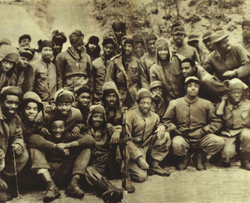
Jesse L. Brown became the U.S. Navy's first black aviator in October 1948. He died when his plane was shot down during the Battle of Chosin Reservoir in North Korea. He was unable to parachute from his crippled F4U Corsair and crash-landed successfully. His injuries and damage to his aircraft prevented him from leaving the plane. A white squadron mate, Thomas Hudner, crash-landed his F4U Corsair near Brown and attempted to extricate Brown but could not and Brown died of his injuries. Hudner was awarded the Medal of Honor for his efforts. The U.S. Navy honored Jesse Brown by naming a frigate after him—the USS Jesse L. Brown (FF-1089).[97]
Two enlisted men from the 24th Infantry Regiment (still a segregated unit), Cornelius H. Charlton and William Thompson, posthumously received the Medal of Honor for actions during the war.
U.S president Harry Truman decided to desegregate the armed forces on July 26, 1948.[98] Truman believed that passing this order would help end racial discrimination. After two years went by North Korea invaded South Korea and the United States decided to send African Americans troopers over also. The war was very difficult for African American soldiers because they didn’t get a lot of respect from their comrades. In 1950, the American military arrested fifty members of all-black 24th infantry and falsely accused them of AWOL and cowardice in the presence of the enemy.[98] Even though Harry Truman signed this executive order for desegregation in the armed forces, African Americans still had to come over other obstacles like falsely being accused and charged with actions they never committed while they were in active duty. Black companies were already miss-treated and when they came across an actual battle the results were devastating. 300,000 Chinese troops stormed across the Yalu River on November 24, 1950, and the 503rd Battalion found themselves directly in the line of fire.[98] Since the all-black battalion wasn’t getting treated fairly and didn’t get the correct amount of supplies every other company got to fight back they lost the battle. Many were killed and many were locked up in a Chinese prison. The conditions in these prisons were cold and not enough food. The African American soldiers spent up to three years in the prisons. The reason for this was because the Chinese captors believed that African Americans were particularly vulnerable to anti-American propaganda because of the discrimination they faced back home and in their units. As a result, the Chinese subjected African Americans to anti-capitalist and anti-imperial brainwashing more than their white counterparts.[98] African Americans were able to now fight in the wars but they still faced lots of acoustics and the Korean war was one of the hardest wars for an African American soldier fighting for his country. Through all this adversity about 600,000 African Americans served in the armed forces during the war and 5,000 lost their life in combat. Many were awarded the Distinguished Service Cross, Silver Star and Bronze Star. African Americans served alongside non colored and killed an estimated 406,000 enemy soldiers.
Vietnam War
.jpg)
The Vietnam War saw many great accomplishments by many African Americans, including twenty who received the Medal of Honor for their actions. African Americans were over-represented in hazardous duty and combat roles during the conflict, and suffered disproportionately higher casualty rates. Civil-rights leaders protested this disparity during the early years of the war, prompting reforms that were implemented in 1967–68 resulting in the casualty rate dropping to slightly higher than their percentage of the total population.[99][100][101][102]
In 1967, President Lyndon B. Johnson presented the Medal of Honor to U.S. Army Specialist Five Lawrence Joel, for a "very special kind of courage—the unarmed heroism of compassion and service to others." Joel was the first living African American to receive the Medal of Honor since the Mexican–American War. He was a medic who in 1965 saved the lives of U.S. troops under ambush in Vietnam and defied direct orders to stay to the ground, walking through Viet Cong gunfire and tending to the troops despite being shot twice himself. The Lawrence Joel Veterans Memorial Coliseum in Winston-Salem, North Carolina, is dedicated to his honor.[103]
On August 21, 1968, with the posthumous award of the Medal of Honor, U.S. Marine James Anderson, Jr. became the first African-American U.S. Marine recipient of the Medal of Honor for his heroic actions and sacrifice of life.
On December 10, 1968, U.S. Army Captain Riley Leroy Pitts became the first African-American commissioned officer to be awarded the Medal of Honor. His medal was presented posthumously to his wife, Eula Pitts, by President Lyndon B. Johnson.
Three out of the 21 African-American Medal of Honor recipients who served in Vietnam were members of the 5th Special Forces Group otherwise known as The Green Berets. These men are as follows: Sergeant First Class Melvin Morris, SFC. Eugene Ashley, Jr., and SFC. William Maud Bryant.
Melvin Morris received the Medal of Honor 44 years after the action in which he earned the Distinguished Service Cross. Sergeant Ashley's medal was posthumously awarded to his family at the White House by Vice President Spiro T. Agnew on December 2, 1969.
Post-Vietnam to present day

In 1989, President George H. W. Bush appointed Army General Colin Powell to the position of Chairman of the Joint Chiefs of Staff, making Powell the highest-ranking officer in the United States military. Powell was the first, and is so far the only, African American to hold that position. The Chairman serves as the chief military adviser to the President and the Secretary of Defense. During his tenure Powell oversaw the 1989 United States invasion of Panama to oust General Manuel Noriega and the 1990 to 1991 Gulf War against Iraq. General Powell's four-year term as Chairman ended in 1993.
General William E. "Kip" Ward was officially nominated as the first commander of the new United States Africa Command on July 10, 2007 and assumed command on October 1, 2007.
The previous Sergeant Major of the Marine Corps, Ronald L. Green, is African-American.
On January 20, 2009, Barack Obama was inaugurated as President of the United States, making him ex officio the first African-American Commander-in-Chief of the United States Armed Forces.
Military history of African Americans in popular culture
The following is a list of notable African-American military members or units in popular culture.
| Release Date (or Year) | Name (or event) | Notability | Reference |
|---|---|---|---|
| 1944 | The Negro Soldier | a Frank Capra recruitment documentary | [104] |
| 1945 | Wings for This Man | a "propaganda" short about the Tuskegee Airmen was produced by the First Motion Picture Unit of the Army Air Forces. The film was narrated by Ronald Reagan. | [105] |
| 1972 | DC Comics | John Stewart of the Green Lanterns was created as an African-American Marine | |
| 1984 | A Soldier's Story | a 1984 drama film directed by Norman Jewison, based upon Charles Fuller's Pulitzer Prize-winning Off Broadway production A Soldier's Play. A black officer is sent to investigate the murder of a black sergeant in Louisiana near the end of World War II. | [106] |
| 1989 | Glory | film featuring the 54th Union regiment composed of African-American soldiers. Starring Denzel Washington and Matthew Broderick | |
| 1990 | The Court-Martial of Jackie Robinson | A film about the early life of the baseball star in the army, particularly his court-martial for insubordination regarding segregation. | |
| January 31, 1992 | Family Matters ABC TV series | In the episode entitled "Brown Bombshell", Estelle (portrayed by actress Rosetta LeNoire) is determined to share the stories of her late fighter-pilot husband and World War II's Tuskegee Airmen to an uninterested Winslow clan. Eventually, she is invited to share her stories to Eddie's American history class. | [107] |
| 1996 | The Tuskegee Airmen | Produced and aired by HBO and starring Laurence Fishburne. | [108] |
| 1997 | G.I. Joe action figure series | The Tuskegee Airmen are represented. | [109] |
| 1999 | Mutiny | TV made film of the 1944 Port Chicago disaster | |
| 2001 | The Wild Blue: The Men and Boys who Flew the B-24s over Germany | Book by Stephen Ambrose in which the Tuskegee Airmen are mentioned and honored. | [110] |
| 2001–2005 | JAG | The Commander Peter Ulysses Sturgis Turner (played by Scott Lawrence) is an African-American Navy Officer in the JAG TV series. Former submarine officer, he serves now as lawyer in JAG | |
| 2002 | JAG: "Port Chicago" | The television drama features the incident | |
| 2002 | Hart's War | a film about a World War II prisoner of war (POW) based on the novel by John Katzenbach | |
| 2004 | Silver Wings and Civil Rights: The Fight to Fly | this documentary was the first film to feature information regarding the "Freeman Field Mutiny", the struggle of 101 African-American officers arrested for entering a white officers' club. | [111] |
| 2005 | Willy's Cut & Shine | a play by Michael Bradford depicting African-American World War II soldiers and the troubles they encounter upon returning home to the Deep South. | [112] |
| 2008 | Miracle at St. Anna | Italian epic war film set primarily in Italy during German-occupied Europe in World War II. Directed by Spike Lee, the film is based on the eponymous 2003 novel by James McBride, who also wrote the screenplay. | [113] |
| 2009 | Fly | a play about the Tuskegee Airmen | [114] |
| 2010 | For Love of Liberty | a PBS documentary television series that portrays African-American servicemen and women and their dedicated allegiance to the United States military. | [115] |
| 2012 | Red Tails | George Lucas announced he was planning a film about the Tuskegee Airmen. In his release Lucas says, "They were the only escort fighters during the war that never lost a bomber so they were, like, the best." | [116] |
See also
- African-American mutinies in the United States Armed Forces
- Afro-Asian
- Military history of the United States
- United States Colored Troops
- List of African American Medal of Honor recipients
- Frederick C. Branch
- Benjamin O. Davis
- Martin Delany
- Daniel "Chappie" James, Jr.
- National Association for Black Veterans
- List of African-American astronauts
- African-American discrimination in the U.S. Military
- Racial segregation in the United States Armed Forces
- Hispanics in the United States Marine Corps
Notes
- Gary B. Nash, "The African Americans Revolution", in Oxford Handbook of the American Revolution (2012) edited by Edward G Gray and Jane Kamensky, pp. 250–70, at p. 254.
- Ray Raphael, A People's History of the American Revolution (2001), p. 281.
- "Selig, Robert A. "The Revolution's Black Soldiers" orig. published summer, 1997". AmericanRevolution.org. Retrieved April 30, 2017.
- Gray, Jefferson M., "Francis Marion Foils the British", Military History Quarterly, August 3, 2011.
- Shaw, Henry I., Jr.; Donnelly, Ralph W. (2002). "Blacks in the Marine Corps" (PDF). Washington, DC: History and Museums Division, Headquarters USMC. Retrieved June 1, 2011.
- Morris, Steven (December 1969). "How Blacks Upset The Marine Corps: 'New Breed' leathernecks are tackling racist vestiges". Ebony. Johnson Publishing Company. 25 (2): 55–58. ISSN 0012-9011.
- MacGregor, Morris J. (1981). Center of Military History, U.S. Army (ed.). Integration of the Armed Forces, 1940–1965. Government Printing Office. pp. 100–102. ISBN 0-16-001925-7.
- "U.S. Senate: Battle of Lake Erie". Senate.gov. Retrieved April 30, 2017.
- Copes, p. 63. This is in some dispute. See here Archived January 22, 2012, at the Wayback Machine
- Battie, Charles A. (1932). "Rhode Island African American Data: HANNIBAL COLLINS". Negroes of Rhode Island. Rhode Island Genealogy Trails. Retrieved June 12, 2012.
- "African American History & the Civil War(CWSS)". NPS.gov. Archived from the original on April 6, 2011. Retrieved April 30, 2017.
- Charles Ball Slavery in the United States: A Narrative of the Life and Adventures of Charles Ball, a Black Man, Who Lived Forty Years in Maryland, South Carolina and Georgia, as a Slave Under Various Masters, and was One Year in the Navy with Commodore Barney, During the Late War (New York: John S. Taylor 1837).
- Charles E. Brodine, Michael J. Crawford and Christine F. Hughes, editors Ironsides! The Ship, the Men and the Wars of the USS Constitution (Fireship Press, 2007), 50.
- Elizabeth Dowling Taylor A Slave in the White House: Paul Jennings and the Madison's Palgrave (McMillen: New York 2012), p. 49.
- Register of Patients at Naval Hospital Washington DC 1814 With the Names of American Wounded from the Battle of Bladensburg Transcribed with Introduction and Notes by John G. Sharp Harry Jones was patient number 35 and see note 8. Accessed 22 May 2018.
- The text of the proclamation has been widely published, and copies of the printed original are in UK National Archives WO 1/143 f31 and ADM 1/508 f579.
- Morriss, p. 98.
- William S. Dudley, editor The Naval War of 1812: A Documentary History Volume II. (Naval Historical Center: Washington, DC 1992), 324–325.
- Alan Taylor, The Internal Enemy Slavery and War In Virginia. 1772–1832 (WW Norton & Company: New York, 2013), pp. 300–305 and Appendix B.
- Sharp, John G., The Recruitment of African Americans in the U.S. Navy 1839, Naval History and Heritage Command 2019. Retrieved March 6, 2019.
- Herbert Aptheker "Negro Casualties in the Civil War" The Journal of Negro History, Vol. 32, No. 1 (January 1947), p. 12.
- Bruce Levine, Confederate Emancipation: Southern Plans to Free and Arm Slaves during the Civil War (2005).
- William H. Leckie and Shirley A. Leckie, The Buffalo Soldiers: A Narrative of the Black Cavalry in the West (University of Oklahoma Press, 2012).
- Charles L. Kenner, Buffalo Soerldiers and Officers of the Ninth Cavalry, 1867–1898: Black and White Together, University of Oklahoma Press, 2014.
- Frank N. Schubert, Black Valor: Buffalo Soldiers and the Medal of Honor, 1870–1898 (1997).
- Heitland, Jason. "The Role of the Buffalo Soldiers During the Plains Indian Wars". us7thcavcof.com. Retrieved July 12, 2011.
- McCard, Harry Stanton; Turnley, Henry (1899). "History of the Eighth Illinois United States Volunteers". Chicago: E. F. Harman & Co. Cite journal requires
|journal=(help) - "A HOMAGE TO DAVID FAGEN, AFRICAN-AMERICAN SOLDIER IN THE PHILIPPINE REVOLUTION". www.academia.edu. p. 20. Retrieved December 15, 2015.
- "Rudy Rimando, "Interview with Historical Novelist William Schroder: Before Iraq, There Was the Philippines", November 28, 2004, hnn.us History news Network". HNN.us. Retrieved April 30, 2017.
- Ryan, David (2014). Cullinane, Michael Patrick (ed.). U.S. Foreign Policy and the Other. Berghahn. pp. 114–115. ISBN 978-1782384397. Retrieved August 3, 2015.
- William T. Bowers; William M. Hammond; George L. MacGarrigle (May 1997). Black Soldier, White Army: The 24th Infantry Regiment in Korea. DIANE Publishing. pp. 12. ISBN 978-0-7881-3990-1.
- "The Saga of David Fagen". Archive.org. 27 October 2009. Archived from the original on 27 October 2009. Retrieved April 30, 2017.CS1 maint: BOT: original-url status unknown (link)
- Gilmore, Gerry J. (February 2, 2007). "African-Americans Continue Tradition of Distinguished Service". United States Army. Retrieved July 5, 2019.CS1 maint: ref=harv (link)
- Scott, Emmett J (1919). Scott's Official History of The American Negro in the World War. p. 346. Retrieved February 9, 2014.
- Patterson, Michael Robert. "Freddie Stowers, Corporal, United States Army". ArlingtonCemetery.net. Retrieved April 30, 2017.
- "African American World War II Medal of Honor Recipients". U.S. Army Center of Military History. February 3, 2011. Retrieved July 18, 2011.
- Video: U.S. Air ForAllied Bombers Strike On Two Fronts Etc (1945). Universal Newsreel. 1945. Retrieved February 21, 2012.
- "Complete History of the Colored Soldiers in the World War". New York: Bennett & Churchill. 1919. Cite journal requires
|journal=(help) - Sweeney, W. Allison (1919). "History of the American Negro in the Great World War".
- Scott, Emmett J (1919). Scott's Official History of The American Negro in the World War. p. 316. Retrieved February 9, 2014.
- African Americans in the Spanish Civil War: "This Ain't Ethiopia, But It'll Do." Edited by Danny Duncan Collum. Victor A. Berch, chief researcher. New York: G.K. Hall and Co., 1992.
- Aric Putnam "Ethiopia is Now: J. A. Rogers and the Rhetoric of Black Anticolonialism During the Great Depression", Rhetoric & Public Affairs – Volume 10, Number 3, Fall 2007, p. 419.
- Gerald A. Danzer, J. Jorge Klor De Alva, Larry S. Krieger (2003). The Americans: Reconstruction to the 21st Century. McDougal Littell.CS1 maint: multiple names: authors list (link)
- Rowley, Hazel (2008). Richard Wright: The Life and Times. University of Chicago Press. p. 97. ISBN 978-0-226-73038-7.
- "Abraham Lincoln Brigade: Spanish Civil War History and Education: James Lincoln Holt Peck". ALBA-VALB.org. Retrieved April 30, 2017.
- Gail Lumet Buckley, American Patriots: The Story of Blacks in the Military from the Revolution to Desert Storm, ISBN 978-0-375-50279-8
- "O'Reilly, Salaria Kee (1913-1991) - The Black Past: Remembered and Reclaimed". BlackPast.org. Retrieved April 30, 2017.
- The Pittsburgh Courier, December 13, 1941, p. 1.
- "Phyllis Mae Dailey: First Black Navy Nurse - The National WWII Museum Blog". NWW2M.com. March 2012. Retrieved April 30, 2017.
- Lee, Ulysses (1966). The Employment of Negro Troops. U.S. Army.
- http://www.sarahsundin.com/port-chicago-the-mutiny-trial-2/
- Young, William H.; Young, Nancy K., eds. (2010), World War II and the Postwar Years in America: A Historical and Cultural Encyclopedia, Volume 1, ABC-CLIO, p. 534, ISBN 978-0-313-35652-0
- Colley, David (2006), African American Platoons in WWI, www.historynet.com
- "African American Platoons in World War II | HistoryNet". HistoryNet. October 20, 2006. Retrieved July 1, 2016.
- Michael Clodfelter. Warfare and Armed Conflicts- A Statistical Reference to Casualty and Other Figures, 1500–2000. 2nd Ed. 2002 ISBN 0-7864-1204-6.
- George Thompson, "Plaque for African American D-Day veterans unveiled at Carew", Western Telegraph, June 5, 2019.
- "D-Day: African-American soldiers remembered for war efforts", BBC News, June 6, 2019.
- "Black Soldiers Honored On 75th Anniversary of D-Day", ColorLines, June 7, 2019.
- Antill, Peter (2003), "Peleliu, battle for (Operation Stalemate II) – The Pacific War's Forgotten Battle, September–November 1944", HITTING THE BEACH 3rd paragraph.
- "Historic California Posts: Camp Lockett". Retrieved January 17, 2008.
- "The 28th Cavalry: The U.S. Army's Last Horse Cavalry Regiment". Archived from the original on December 20, 2007. Retrieved April 24, 2007.
- "Defending the Border: The Cavalry at Camp Lockett". Retrieved January 17, 2008.
- Unit subsequently reorganized and redesignated the 46th Field Artillery Group.
- Unit subsequently reorganized and redesignated as the 333rd Field Artillery Group.
- Unit subsequently reorganized and redesignated as the 349th Field Artillery Group.
- Unit subsequently reorganized and redesignated as the 350th Field Artillery Regiment
- Unit subsequently reorganized and redesignated the 351st Field Artillery Group.
- Subsequently, unit reorganized and redesignated the 353rd Field Artillery Group
- Unit subsequently reorganized and redesignated the 578th Field Artillery Group
- Magazine, Seabee. "Building for a Nation and Equality: African American Seabees in World War II".
- This week in Seabee History, Sept 17–23, Seabee Online Magazine, NAVFAC Engineering Command, Wash. Navy Yard, DC. live.mil/326-2/
- Historical Content Significance, Naval Aviation Supply Depot Hut 33 at Waiawa Gulch, Peral City, U.S. Dept of Interior, Nat. Park Service, p. 10
- Ratomski, John J. "Peleliu Shore Party". Tribute to Michael A. Lazaro and all other Peleliu Veterans. Retrieved 18 October 2017.
- "17th Special NCB cruisebook" (PDF). Naval History and Heritage Command. 1946. pp. 29, 30. Retrieved October 18, 2017.
- "Seabees of 17th Special Naval Construction Battalion wait to assist wounded of 7th Marines". World War II Database. Retrieved October 18, 2017.
- "African-American Marines of 16th Field Depot Rest on Peleliu". World War II Database. Retrieved 18 October 2017.
- "17 Special Naval Construction Battalion" (PDF). Naval History and Heritage Command. Retrieved 18 October 2017.
- Princeton University Library, Marine Corps Chevron, Vol 3 Number 48, December 2, 1944
- Peleliu, battle for (Operation Stalemate II) – The Pacific War's Forgotten Battle, September–November 1944, (section: Hitting the Beach, 3rd paragraph), Military History Encyclopedia on the Web, by: Peter D Antill, Tristan Dugdale-Pointon, and Dr John Rickard,
- 1st Marine Pioneers, PRESIDENTIAL UNIT CITATION, First Marine Division, Reinforced, Assault and seizure of Peleliu and Ngesebus, Palau Islands, Part II. UNIT AWARDS, Section 1, Navy-Marine Corps Awards Manual(Rev 1953) p.15 Naval History and Heritage Command,
- The Right to Fight: African American Marines in WWII, Peleliu and Iwo Jima, Bernard C. Naulty, Marine Corps Historical Center, Building 58, Washington Navy Yard, Washington D.C. 20374, 1974, PCN 190-003132-00
- African Americans at War: an Encyclopedia, Volume I, Jonathan D. Sutherland, ABC, CLIO, Santa Barabra, Ca, 2004, p. 480, ISBN 1-57607-746-2
- "17th Special NCB cruisebook" (PDF). Naval History and Heritage Command. p. 29. Retrieved 18 October 2017.
- The Sextant, Building for a Nation and for Equality: African American Seabees in World War II – March 4, 2014, Dr. Frank A. Blazich Jr., U.S. Navy Seabee Museum, Naval History and Heritage Command webpage
- Breaking Down Barriers: The 34th Naval Construction Battalion, by the Seabee Museum, Port Huemene, CA. Feb 7 2018
- "World War II African American Medal of Honor Recipients". United States Army Center of Military History.
- Jones, p. 2.
- McGuire, p. 146.
- Shilts, p. 164.
- Bérubé, p. 230.
- Bérubé, p. 241.
- Bérubé, p. 234.
- Associated Press (May 21, 1947). "Army to abandon 'blue' discharge". Jefferson City (MO) Daily Capital News. p. 1.
- Department of Defense Directive 5120.36
- Heather Antecol and Deborah Cobb-Clark, Racial and Ethnic Harassment in Local Communities. October 4, 2005. p 8
- John Sibley Butler. "Affirmative Action in the Military Annals of the American Academy of Political and Social Science", Vol. 523, Affirmative Action Revisited (September 1992), p. 196.
- "USS Jesse L. Brown". Naval Historical Center, Department of the Navy.
- "African Americans In Korean War". Koreanwarlegacy.org. 2020.
- War within war; The Guardian; September 15, 2001
- Working-Class War: American Combat Soldiers and Vietnam: American Combat; Christian G. Appy; University of North Carolina Press; p. 19.
- Fighting on Two Fronts: African Americans and the Vietnam War; Westheider, James E.; New York University Press; 1997; pp. 11–16.
- African-Americans In Combat
- "Who is Lawrence Joel?". Lawrence Joel Veterans Memorial Coliseum – Winston-Salem, North Carolina. Archived from the original on December 28, 2010. Retrieved 2007-01-13.
- The Negro Soldier on IMDb
- Wings for This Man on IMDb
- A Soldier's Story on IMDb
- "TV.com Family Matters Episodes: Season 3". Retrieved January 1, 2007.
- The Tuskegee Airmen on IMDb
- "1997 G.I. Joe Classic Collection". MasterCollector.com. Archived from the original on June 17, 2007. Retrieved April 30, 2017.
- Ambrose, Stephen Edward The Wild Blue: The Men and Boys who Flew the B-24s over Germany, Simon & Schuster, 2001, Chapter 9, p. 27
- "Silver Wings and Civil Rights: The Flight to Fly". Fight2Fly.com. Archived from the original on March 20, 2005. Retrieved April 30, 2017.
- Bradford, Michael (2006). Willy's Cut & Shine (first 15 pages) (PDF) (Second ed.). Broadway Play Publishing Inc. ISBN 0-88145-269-6. Archived from the original (PDF) on 2014-10-11. Retrieved 2013-12-11.
- Miracle at St. Anna.
- Gates, Anita, "Breathing new life into an oft-told tale," The New York Times, October 9, 2009, retrieved September 29, 2012
- "For Love of Liberty: The Story of America's Black Patriots". ForLoveOfLiberty.org. Retrieved April 30, 2017.
- "Exclusive: Lucas looks to the future". FilmFocus.co.uk. Archived from the original on April 4, 2013. Retrieved April 30, 2017.
References
- Bérubé, Allan (1990). Coming Out Under Fire: The History of Gay Men and Women in World War Two. New York, The Penguin Group. ISBN 0-452-26598-3 (Plume edition 1991).
- Copes, Jan M. (Fall 1994). "The Perry Family: A Newport Naval Dynasty of the Early Republic". Newport History: Bulletin of the Newport Historical Society. Newport, RI: Newport Historical Society. 66, Part 2 (227): 49–77.
- Jones, Major Bradley K. (January 1973). "The Gravity of Administrative Discharges: A Legal and Empirical Evaluation" The Military Law Review 59:1–26.
- McGuire, Phillip (ed.) (1993). Taps for a Jim Crow Army: Letters from Black Soldiers in World War II. University Press of Kentucky. ISBN 0-8131-0822-5.
- Morriss, Roger (1997). Cockburn and the British Navy in Transition: Admiral Sir George Cockburn, 1772–1853. Columbia, South Carolina: University of South Carolina Press. ISBN 1-57003-253-X
- Shilts, Randy (1993). Conduct Unbecoming: Gays & Lesbians in the U.S. Military Vietnam to the Persian Gulf. New York, St. Martin's Press. ISBN 0-312-09261-X
Further reading
- Alt, William E.; Alt, Betty L. (2002). Black Soldiers, White Wars: Black Warriors from Antiquity to the Present. Praeger. ISBN 978-0-275-97621-7.
- Binkin, Martin & Eitelberg, Mark J. (1982). Blacks and the Military. Brookings Institution. ISBN 978-0815709749
- Buckley, Gail (2001). American Patriots:The Story of Blacks in the Military From the Revolution to Desert Storm. Random House. ISBN 978-0-375-76009-9.
- Dalessandro, Robert J.; Gerald Torrence (2009). Willing Patriots: Men of Color in the First World War. Schiffer. ISBN 978-0-7643-3233-3.
- David, Jay; Crane, Elaine (1971). The Black Soldier. William Morrow and Company, Inc. ISBN 978-0-688-06037-4.
- Dixon, Chris. 2018. African Americans and the Pacific War, 1941–1945: Race, Nationality, and the Fight for Freedom. Cambridge University Press.
- Fletcher, Marvin E. (1974). The Black Soldier and Officer in the United States Army 1891–1917. University of Missouri. ISBN 978-0-8262-0161-4.
- Foner, Jack D. (1974). Blacks and the Military in American History. Praeger.
- Gibson, Truman K., Jr.; Steve Huntley (2005). Knocking Down Barriers: My Fight for Black America. Northwestern University Press. ISBN 0-8101-2292-8.
- Höhn, Maria; Martin Klimke (2010). A Breath of Freedom: The Civil Rights Struggle, African American GIs, and Germany. Palgrave Macmillan. ISBN 978-0-230-10473-0.
- Knauer, Christine (2014). Let Us Fight as Free Men: Black Soldiers and Civil Rights. Philadelphia: University of Pennsylvania Press.
- Lindenmeyer, Otto (1970). Black and Brave: The Black Soldier in America. McGraw-Hill Book Company. ISBN 978-0-07-037876-6.
- Nell, William C. (1855). The Colored Patriots of the American Revolution.
- Schubert, Frank N. (1997). Black Valor: Buffalo Soldiers and the Medal of Honor, 1870–1898. Scholarly Resources Inc. ISBN 9780842025867.
- Scott, Emmett J. Scott's Official History of The American Negro in the World War. Retrieved February 9, 2014.
- Sutherland, Jonathan. (2004). African Americans at War: An Encyclopedia. Santa Barbara, California: ABC-CLIO. ISBN 978-1-57607-746-7
- White, Steven. 2019. World War II and American Racial Politics: Public Opinion, the Presidency, and Civil Rights Advocacy. Cambridge University Press.
Navy
- Aptheker, Herbert. "The Negro in the Union Navy." Journal of Negro History (1947): 169–200. in JSTOR
- Bennett, Michael J. Union Jacks: Yankee Sailors in the Civil War: Yankee Sailors in the Civil War (University of North Carolina Press, 2005)
- Bureau of Naval Personnel, "The Negro in the Navy in World War II." Washington, 1947. 103 pp. online
- Davis, Michael Shawn. "'Many of them are among my best men': The United States Navy looks at its African American crewmen, 1755–1955." PhD dissertation, Kansas State University (2011). online, with detailed bibliography, pp. 216–241
- Jackson, Luther P. "Virginia Negro Soldiers and Seamen in the American Revolution." Journal of Negro History (1942): 247–287. in JSTOR
- Langley, Harold D. "The Negro in the Navy and Merchant Service—1789-1860 1798." Journal of Negro History (1967): 273–286. [ in JSTOR]
- Miller, Richard E. (2004). The Messman Chronicles: African Americans in the U.S. Navy, 1932–1943. Naval Institute Press. ISBN 1-55750-539-X.
- Miller, Richard E. "The Golden Fourteen, Plus: Black Navy Women in World War One." Minerva: A Quarterly Report on Women and the Military 8.3&4 (1995): 7–13.
- Nelson, Dennis D. The Integration of the Negro into the U.S. Navy, 1776–1947 (NY: Farrar Strauss, 1951)
- Ramold, Steven J. Slaves, Sailors, Citizens: African Americans in the Union Navy (2002)
- Reddick, Lawrence D. "The Negro in the United States Navy During World War II." Journal of Negro History (1947): 201–219. in JSTOR
- Schneller, Jr. Robert J. Blue & Gold and Black: Racial Integration of the U.S. Naval Academy (Texas A&M University Press, 2008)
- Valuska, David L. The African American in the Union Navy, 1861–1865 (Garland Pub., 1993)
- Williams III, Charles Hughes. "We Have … Kept The Negroes' Goodwill And Sent Them Away": Black Sailors, White Dominion In The New Navy, 1893–1942, PhD Dissertation. Texas A&M University, 2008. online
External links
| Wikimedia Commons has media related to African American soldiers. |
- McDaniels III, Pellom: African American Soldiers (USA), in: 1914-1918-online. International Encyclopedia of the First World War.
- Sheffer, Debra J.: Racism in the Armed Forces (USA), in: 1914-1918-online. International Encyclopedia of the First World War.
- "African Americans in the U.S. Army". U.S. Army.
- "Blacks in the U.S. Army: Then and Now". U.S. Army.
- "Story of America's Black Patriots". U.S. Army. Archived from the original on September 26, 2010. Retrieved April 16, 2019.
- Simpson, Diana (compiled by) (February 1999). "African-Americans in Military History". Air University Library, Maxwell Air Force Base.
- "Black History at Arlington National Cemetery". Historical Information. Arlington National Cemetery. Archived from the original on 2000-08-17. Retrieved 2007-07-04.
- Black Confederates documentary book
- "Black Military World".
- "Black Military History: African Americans in the service of their country". Father Ryan High School. Archived from the original on 2007-04-03. Retrieved December 23, 2005.
- "A Chronology of African American Military Service: From the Colonial Era through the Antebellum Period". Archived from the original on 2009-10-02.
- First Kansas Colored Infantry flag, Civil War, Kansas Museum of History
- The "Colored" Soldiers, Kansas Historical Society
- Military history of African Americans is available for free download at the Internet Archive
- "The Tuskegee Airmen of World War II at Pritzker Military Museum and Library".

